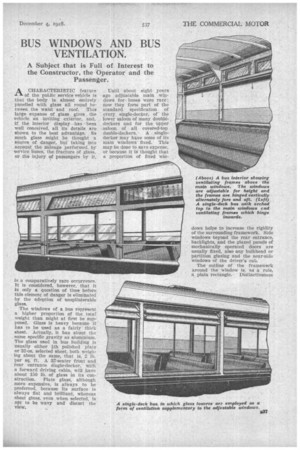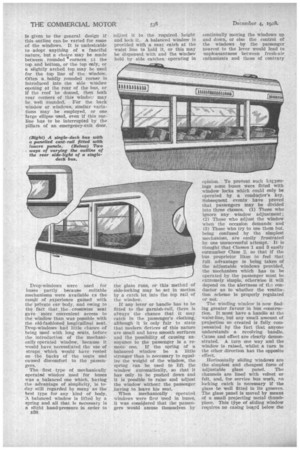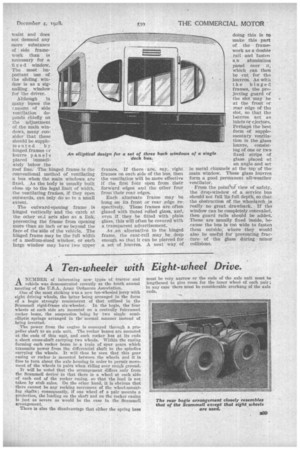BUS WINDOWS AND BUS VENTILATION.
Page 21

Page 22

Page 23

If you've noticed an error in this article please click here to report it so we can fix it.
A Subject that is Full of Interest to the Constructor, the Operator and the Passenger.
ACHARACTERISTIC feature of the pullic service vehicle is that the body is almost entirely panelled with glass all round between the waist and roof. This large expanse of glass gives _ the vehicle an inviting exterior, and, if the interior display. has • been well conceived, all its details are shown to the best advantage.. So much glass might be thought a source of danger, but taking into account the mileage performed, by service buses, the fracture Of glass, or the injury of passengers by it,
is a comparatively rare occurrence. It is considered, however, that it is only a question of time before this element of danger is eliminated by the adoption of unsplinterable glass.
The windows of a bus represent a higher proportion of the, total weight than might at first be supposed. Glass is heavy because it has to be used as a fairly thick sheet. Actually, it has about the same specific gravity as aluminium. The glass used in bus building is usually either ith polished plate or 32-oz. selected sheet, both weighing about the same, that is, 2. lb. per sq. ft. A 32-seater front and rear entrance Single-decker, With a forward driving cabin, will have about 150 lb. of glass in its construction. Plate glass, although more expensive, is always to be preferred, because its surface is always flat and brilliant, whereas sheet glass, even when selected, is apt to be wavy and distort the view. Until about eight years ago adjustable main windows for buses were rare; now they form part of the standard specification of every single-decker, of the lower saloon of many, double-deckers and for the upper saloon of all covered-top double-deckers. A singledecker may have some of its main windows fixed. This may-be done to save expense, or because it iS thought that a proportion of fixed win
dows helps to increase the rigidity of the surrounding framework. Side windows beyond the rear entrance, backlights, and the glazed panels of mechanically operated doors are usually fixed, also any bulkhead or partition glazing and the near-side windows of the driver's cab.'
The outline of the framework around the window is, as a rule, a plain rectangle. Distinctiveness
Is given to the general design if thisoutline can be varied for some of the windows. It is undesirable to adopt anything of a fanciful nature, but a choice may be made between. rounded °corners z:_t the top and bottom, or the top only, or a slightly arched top may be used for the top line of the window. Often a boldly rounded corner is Introduced into the side window opening at the rear of the bus, or If the roof be domed, then bath rear corners of this window may be, well rounded. For the back window or windows, similar variations may be employed, or one large ellipse used, even if this outline has to be interrupted by the pillars of an emergency-exit door.
Drop-windows were used for buses partly because suitable mechanisms were available es the result of experience gained with the private car body, and owing to the fact that ,the crosswise seat gave more convenient access to the window than was possible with the old-fashioned longitudinal seat. Drop-windows had little chance-of being used with long seats, before the Introduction of the mechanically operated window, because it would have necessitated the use of straps Which would have rested on the backs of the seats and caused discomfort to the passengers.
The first type of mechanically operated window used for buses was a balanced one which, having .111e adyantage of simplicity, is today still regarded by many as the best type for any kind of body. A balanced window is lifted by a spring and all that is necessary is a slight hand-pressure in order to , B38 adjust it to the required height and lock it. • A balanced window is provided with a neat catch at the waist line to hold it, or this may be dispensed with and the window held by aide catches, operating in
the glass runs, or this method of side-locking may be .set in motion by a catch let into the top rail of the window.
If any lever or handle has to be fitted to the garnish-rail, there is always the chance that it may catch in the passenger's clothing, although it is only fair to state that modern devices of this nature are small and have smooth surfaces and the possibility of causing annoyance to the passenger is a remoteone. If the spring of a balanced window be a little stronger than is necessary to equalize the weight of the window, the spring can be used to lift the window automatically, so that it has only to be pushed down and it is possible to raise and adjust the window without the passenger having to leave his seat.
When mechanically operated windows were first used in buses, it was considered that the passengers would amuse themselves by
continually moying the windows up and down, or else the control of the windows by the passenger nearest to the lever would lead to unpleasantness between fresh-air enthusiasts and those of contrary opinion. To prevent such harpenings some buses were fitted with window locks which could only be operated by a conductor's key. Subsequent events have proved that passengers may be divided into three classes. (1) Those who ignore any window adjustment; (2) Those who adjust the window when the occasion demands and (3) Those who try to use them but, being confused by the simplest mechanism, are easily frustrated by one unsuccessful attempt. It is thought that Classes I and 3 easily outnumber Class 2, so that if the bus proprietor likes to feel that full advantage is being taken of the adjustable windows provided, the mechanism which has to be operated by the passenger must be extremely simple, otherwise it will depend on the alertness of the conductor as to whether the ventilation scheme is properly regulated or not.
The winding window is now finding greater favour in bus construction. It must have a handle at the waist-line, but any small amount of projection so created is fully compensated by the fact that anyone understands a revolving handle. Cause and effect are clearly demonstrated. A turn one way and the window is raised, whilst a turn in the other direction has the opposite effect.
Horizontally sliding windows are the simplest and cheapest form of adjustable glass panel. The channels are lined with velvet or felt, and, for service bus work, no locking catch is necessary if the glass be well fitted in its grooves. The glass panel is moved by means of a small projecting metal thumbpiece. This type of sliding window requires no casing board below the waist and does not .demand any more substance of side framework than is necessarY for a fixed window. The most important use of the sliding window is as a signalling . window for the driver.
Although . in many buses the Lmount • of side ventilation depends chiefly on the adjustment of the main. windows, many consider that these should besupplemented by hinged frames er louvre panels placed immediately • below the
roof line. :-.The hinged frame is the conventional method of ventilating a bus when the main windows are fixed. As the body is usually built close up to the legal limit of width, the ventilating frames, if they open outwards, can Only do so to a small extent.
The outward-opening frame . is hinged vertically and the catch at the other end acts also as a link,' preventing the frame from opening more than an inch or so beyond the face of the side of the vehicle. The hinged frame may be the full width of a medium-sized window, or each large window may have two upper frames. If there are, say, eight frames oil each side of the bus, then the ventilation will be more effective if the, first four open from their forward edges and the other four from their rear edges.
Each alternate frame may he hung on its front or rear edge re-. speetively. These frames are often glazed with tinted rolled glass, and, even if they be fitted with plain glass, this will often be cove red with a transparent advertisement.
As an alternative to the hinged frame, the cant-rail may be deep enough so that it can be pierced for a set :of louvres. A neat way, of
doing this is to make this part of the framework as a double rail and 'fasten an aluminitan panel over it; which can then be cut for the louvres. As with the hinged frames, the projecting guard of the slot may he at the front or war edge of the slot, so that the
Nuvres act as inlets or ejectors. Perhaps the best form of supplementary ventilation is the glass louvre, consisting of One or two fixed: strips of glass placed at an angle and set in metal channels at the • top 'of the main window. These glass louvres form a good permanent all-weather ventilator.
From the point'of view of safety, the drop-window of a service bus should not fall 'its full depth, so that the obstruction of the wheelarth is really no great drawback. If the window can be completely concealed, then guard rails should be added. These are usually fixed inside, because the bus is too wide to fasten them outside; where they would also be useful for preventing fracture, of the glass during • minor collisions.






























